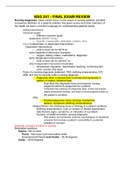NSG 241 - FINAL EXAM REVIEW
Nursing diagnoses: helps nurses focus on the scope of nursing practice; provides
a presence definition of a patients problem that gives nurses and other members of
the health are team a common language for understanding patients needs
Writing interventions
Outcomes (goals)
oEffective outcome (goal) statements SMART Goals
oSpecific, measurable, attainable, realistic, time-
bound Independent vs dependent interventions
Dependent Interventions
owhat a nurse can do WITH an order Dependent Intervention Examples
ooxygen, dietary orders, medications, diagnostic
tests independent Interventions
owhat a nurse can do withOUT an order Independent Interventions Examples
otemperature regulation, readmission teaching, monitoring skin
color, monitor vital signs
Parts of a nursing diagnostic statement: PES, defining characteristics, R/T, AEB, and how to correctly write a nursing diagnosis
Diagnostic label: a concise term or phrase that represents a pattern of related, clustered data
Describes the diagnostic focus and requires nursing judgment before its assignment to a patient
Understand the meaning of a diagnostic label, cluster and analyze related assessment findings, and make a clinical judgment based on
the patient’s condition
PES
Problem(diagnostic label), Etiology (related/risk factors), Symptoms (defining characteristics)
Related factors: the underlying cause or etiology of a patient’s problems
Defining characteristics: cues or clusters of related assessment data that are signs, symptoms, or indication of a problem-
focused, or health promotion nursing diagnostic
Risk factors: environmental, physical, psychological, or situational
concerns that increase a patient’s vulnerability to a potential
problem or concern
Essential concepts of ethics in nursing
Bed/patient positions
Supine - flat on back
Prone - face down (can have pillow under knees/stomach/head) semi-fowler - 30-45 degrees
fowler - 45-60 degrees high fowler - 60-90 degrees
Sims - semi prone lying on left side
dorsal recumbent - supine with legs bent
lithotomy - gyno position; supine with legs bent and out knee-chest - prone with butt in the air - rectal exam
Trendelenburg - supine with legs higher than head
reverse Trendelenburg - feet lower than head
Bed making
Linen change principles
oPrepare supplies and raise the bed to an appropriate level slide the pillowcase off the pillow and place the pillowcase in the center of the bed systematically loosen the linens at the foot of the bed roll the linens toward the center of the bed hold the dirty linens away from you and place them in a laundry bad position and align the mattress to fit the bed frame, and wipe down the mattress with an appropriate solution if needed wash hands and apply clean gloves hold the sheets out on the bed, opening them from side to center and center to side apply the bottom fitted sheet apply a waterproof pad
and movement for the bed apply the top sheet with the hems facing up and apply blanket with seams facing down use mitered corners at the bottom of the bed make a cuff by turning down the top sheet over the top of the blanket make a horizontal toe pleat apply the pillow case place pillow on the bed with open end of the pillow case away from the door place call light in bed
Sterile fields
sterile technique - prevent introduction of microorganisms from the environment to the pt.
o only sterile items in the sterile field border of the sterile field
o1 inch, not sterile
above waist, below elbows, chest
above elbows, back, out of sight, below waist sterile glove technique
opinch and scoop method
broken seals/packaging and wet or damp material are contaminated
Tracheostomy/Nasotracheal/Nasopharyngeal/Oropharyngeal and Oral Suctioning
Oral Pharyngeal Airway OPA
oassisting in maintain tongue position, only for UNCONSCIOUS patients,
sizing and insertion
Nasopharyngeal Airway NPA
oassist in maintaing the airway by keeping tongue forward, can be used with conscious and unconscious patients
Oral care wear gloves, ensure something there for pt to spit in, helps prevent hospital acquired pneumonia
Defense mechanisms
predominately unconscious, protective coping mechanisms that apply in response to a perceived threat
reaction formation - defense mechanism in which one responds to negative thoughts or feelings by demonstrating opposite emotions and actions
sublimination - defense mechanism in which one channels unacceptable emotions or impulses into acceptable actions or response
Primary roles and functions of the nurse
Care provider:
oThe nurse follows the nursing process to assess patient data, prioritize nursing diagnoses, plan the care of the patient, implement the appropriate interventions, and evaluate care in an ongoing cycle
Educator:
oThe nurse ensures that patients receive sufficient information on which
to base consent for care and related treatment
oThe nurse assesses learning needs, plans to meet those needs through specific
teaching strategies, and evaluate the effectiveness of patient teaching
Advocate:
oThe nurse interprets information and provides necessary education, then accepts and respects the patient’s decisions even if they are different from the nurse’s own beliefs
oThe nurse supports the patient’s wishes and communicates them to other health care providers
Leader:
oProvides direction and purpose to others, builds a sense of commitment toward
common goals, communicates effectively, and assists with addressing challenges that arise in the caring for patients in a health care setting
Change agent:
oRequires knowledge of change theory, which encourages change and provides strategies for effecting change
oThe nurse works with the patient to address their health concerns and with
staff members to address change in an organization or within a community
Manager:
oPromoting, restoring, and maintaining the patient’s health requires coordinating all of the health care provider’s service
oIn the hospital will oversee the staff on a patient care unit whole managing the budget and resources for necessary functions
Researchers:
oNurses determine care concerns and ask questions about nursing practices Collaborator:
oInterprofessional collaboration occurs when RN, UAP, LPN, PCP, social workers,
clergy, and therapists all interact productively to provide high-quality patient care




